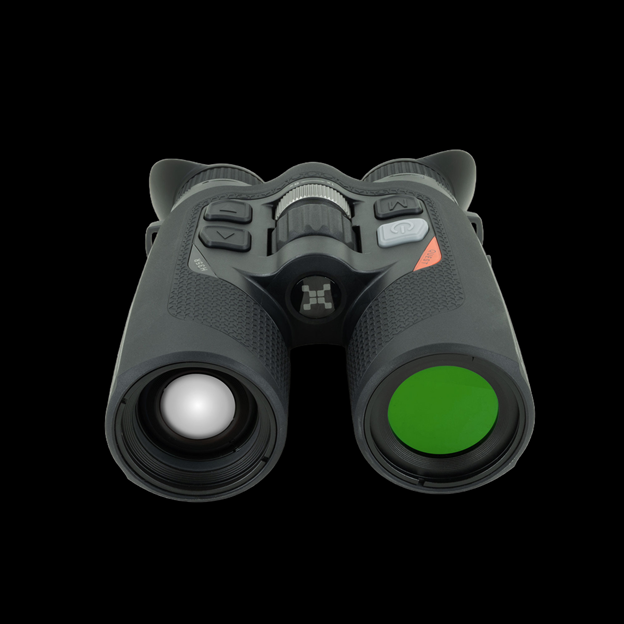For most nocturnal hunters, aside from thermal rifle scopes, the two most common types of thermal optics are probably thermal monoculars and binoculars.
While they are undoubtedly very similar, there are some important differences between the basic design of thermal monoculars and binoculars that you should understand before you buy one over the other, especially if it’s a matter of you getting one or the other, but not both.
Here are a few things to know.
What They Both Do
First things first, both thermal binoculars and monoculars are a lot more similar than they are different. All thermal optics - binoculars and monoculars included - have a thermal sensor that detects the heat signature of infrared radiation and then creates an image on a display that the user views. Thermal vision can be effective in all light conditions, including in total darkness.
This display shows the differences in thermal gradients of a sight picture, with contrast between the hotter and cooler areas of the image. The degree to which a sensor shows detail with respect to temperature gradient is known as NETD; a lower NETD rating will yield a clearer picture.
Thermal monoculars and binoculars will also have a resolution; the higher the resolution, the sharper the image will be. They also offer a frame rate, which is the speed at which the image refreshes on the display. The higher the frame rate, the smoother the image will be and the less a moving target will lag. High performance models may also be capable of taking stills as well as video recording.
That’s what they fundamentally have in common. So what are the relative advantages and disadvantages to each?
Thermal Monoculars: Advantages and Disadvantages

First, let’s start with thermal monoculars, which have only one objective lens and sensor along with one display.
For the most part, thermal monoculars are smaller and more compact and lightweight than thermal binoculars, just by nature of their design. This makes them potentially more effective for hunters that travel light, or for whom pack space is at a premium.
Another general observation of thermal monoculars is that they tend to have longer battery lifespans. Though this is not necessarily always the case, if you’re looking for a longer-lasting thermal optic, a monocular might be the best option.
Also, thermal monoculars tend to be slightly more affordable than thermal binoculars, if only because of the simplicity of the design. Binoculars are, by nature, more complex optics and it costs more to design, engineer, and develop them. This means that, holding all other features and specifications equal, thermal monoculars might be a better choice if price is a primary concern.
Thermal monoculars also have a very important relative advantage for nocturnal hunters, and it has to do with form factor. Since a thermal monocular only requires you to view the sight picture on the display with one eye, it can help keep your other eye acclimated to the darkness so you don’t lose your night vision.
There are things you can do to help avoid this “night blindness” like setting the display to all-red (which helps preserve your night vision) but invariably, using only one eye to view the display preserves your ability to see in the dark in at least one eye. Some consider this a strong advantage for hunters, since the monocular mimics the form factor of a thermal rifle scope.

Thermal Binoculars: Advantages and Disadvantages
Thermal binoculars are binoculars that contain a thermal sensor and which produce a thermal image on two displays, corresponding to the two eyepieces of the binoculars, instead of the single image of a monocular.
Because of this a familiar form factor that enables a user to use both hands and eyes, some consider thermal binoculars more comfortable, intuitive to use, and ergonomic than monoculars. Using two eyes is more natural than using one and it can potentially reduce eye strain, especially in the dark. This eye strain is one thing that night hunters often comment on and using binoculars for scouting, as opposed to thermal monoculars, can help alleviate this potential issue.
These ergonomic features are the main benefits of thermal binoculars, but there are a few potential drawbacks that should also be mentioned.
One is the potentially shorter battery life. Because binoculars utilize two eye pieces, they might not last as long as some alternatives in the form of thermal scopes or monoculars.
Another is that binoculars are, by nature, larger, bulkier, and generally heavier. However, you can also get a bino harness which will save space in your pack and make it easier for you to carry them in the field, circumventing this issue.
Cost is another consideration you will need to make. Many models of thermal binoculars are more expensive than comparable thermal monoculars with similar features, so if you’re working with a price crunch, a monocular might be the better option.
Lastly, while the dual displays of binoculars might result in less eye strain and help prevent headaches, they can produce night blindness that makes it hard to see in the dark when switching back and forth between using the binoculars and actually peering through the darkness. This is the reason why many hunters opt to go with a monocular or a thermal scope instead of thermal binoculars.
However, with all of that said, the choice is yours. There are many high quality thermal monoculars and binoculars out there, and what works for you might not work for the next guy. Get and use what meets your needs.

Important Disclaimer
While the generalities explored in this article are more or less applicable, it is important to note that they are just that: generalities. For instance, while thermal monoculars do tend to be lighter and cheaper than thermal binoculars, this is not always necessarily universally the case. It is important to read the product specifications to make sure you’re aware of each model’s features and functionality.
Explore Thermal Monoculars, Binoculars, Scopes and Other Optics Here
Dark Night Outdoors represents some of the best brands in the thermal optic industry, including RIX, InfiRay, iRayUSA, Nocpix and PULSAR thermal optics. For more information visit our brand pages and if you have any questions or need recommendations for thermal monoculars or binoculars get in touch with us directly.

